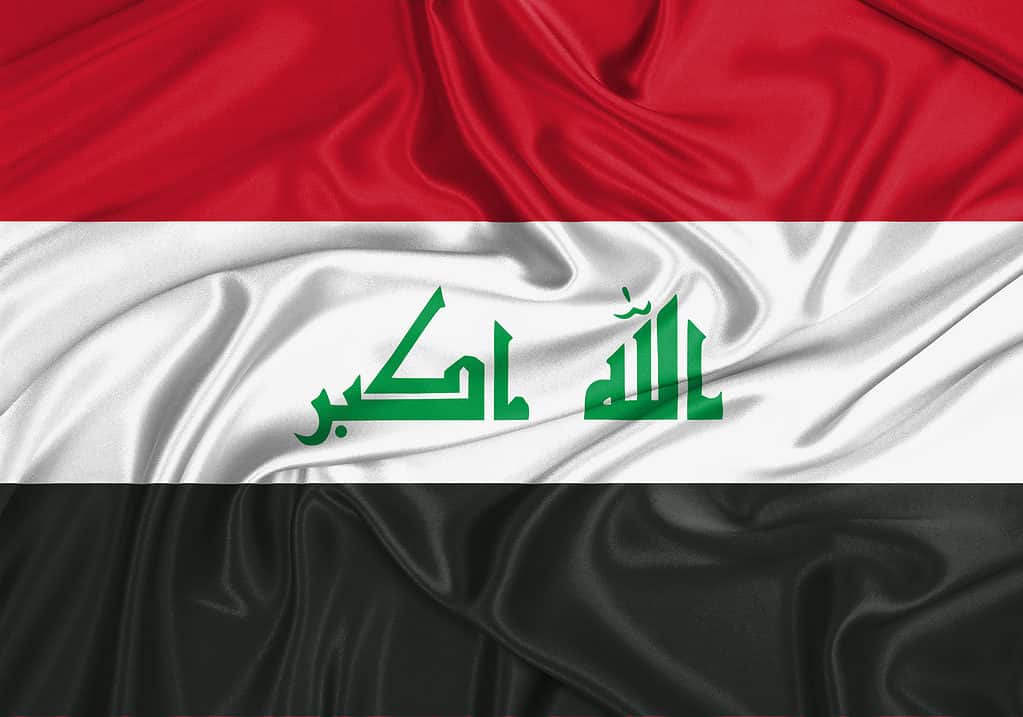Iraq has used many different flags since declaring independence from the Ottoman Empire after World War I. Each flag had its own expression of the country’s culture, incorporating elements of native design, neighboring cultures, and the country’s Arab past. Throughout Iraq’s and the region’s turbulent history, the current flag’s design has changed to reflect the country’s political climate. This article attempts to examine the Iraqi flag by looking into its history and interpreting its meanings and symbols.
Flag of Iraq History

The flag of Iraq has endured many changes based on its history.
©esfera/Shutterstock.com
1921
In 1921, Iraq officially chose a flag that took its inspiration from the banner of the Arab Revolt, which had previously flown throughout the First World War in its fight against the Ottoman Empire.
1959
In 1959, when Abdul Karim Qassim’s movement to remove the monarchy was successful, he replaced the flag with one that did not feature any symbols of the monarchy. Symbols for the country’s minorities, such as Christians and Kurds, were placed on the new flag.
1963
On July 31, 1963, a new flag, based on the Arab Liberation Flag that had originally been raised in Egypt in 1952, took its place. Its tricolor of red, white, and black was already widely recognized in northern Yemen, Egypt, and Syria. The three green stars adopted by Iraq symbolized the country’s intention to join forces with Syria and Egypt. Inspired by a song written in the 13th century by af al-Dn al-illi, the colors pay tribute to the poet’s descriptions of red as a desire to spill blood, green as Arab fields, black as warfare, and white as purity of motivations and acts.
1991
On January 14, 1991, at a time when Iraq was encountering military forces intent on undoing the annexation of Kuwait, President Saddam Hussein ordered a change to the flag that would show an Islamic commitment by adding the Arabic text “Allhu akbar” (God is Great) in between the flag’s three green stars.
2004
The temporary government of Iraq approved a new flag on June 28, 2004; it was nearly identical to the flag flown between 1991 and 2004 except for the width-to-length ratio and the style of the script utilized for the text.
2008
The Iraqi Council of Representatives opted to approve a modified version of the flag on January 22, 2008, with the three green stars removed from the white stripe and the width-to-length ratio returned to what it had been for the flag that flew from 1991 and 2004. On January 28th, it was finally confirmed. The current flag of Iraq was chosen in 2008 and has been in use ever since.
Flag of Iraq Meaning

The Iraqi flag is red, white, and black with the text “Allahu Akbar” in Kufic script in the center.
©Hybrid Gfx/Shutterstock.com
Design
The flag is a rectangle with a width that’s twice as long as the length itself. It’s divided into three equal-width horizontal bands: red at the top, white in the middle, and black at the bottom. In the center of the white rectangle is the green wording “Allahu akbar” written in the Kufic script. There is a 2:3 ratio.
Colors
There are 4 total colors on the flag of Iraq: red, white, and black stripes with green text across the white stripe in the center. Since its first approval on July 31, 1963, the basic tricolor stripes have undergone various modifications, including the removal of the three green stars and their replacement with a dark green takbr. This is the current version adopted on January 22, 2008.
Flag of Iraq Symbolism
The flag of Iraq has changed a lot since its origin. However, its symbolism draws much from its history. Its colors are said to have a few different meanings. In one context, green is the traditional color of Islam; red represents bravery; white represents generosity; and black represents victory. The white section is also said to depict the subsequent Ummayad Caliphate. This drew inspiration from Muhammad’s black banner and the Rashidun Caliphate. The Fatimid Caliphate is often credited with popularizing the use of green as a symbol of Islam. Red is said to be a symbol of the Khawarji uprising. The early 20th century saw the independence of Arab nations from the Ottoman Empire. The pan-Arab tricolor is also a symbol of the solidarity of these states. These colors as a whole make a strong message about Arab nationalism and identity.
Up Next:
- The Flag of Benin: History, Meaning, and Symbolism
- The Flag of Angola: History, Meaning, and Symbolism
- The Flag of Oman: History, Meaning, and Symbolism
The photo featured at the top of this post is © Design_Bank/Shutterstock.com
Sources
- Wikipedia, Available here: https://en.wikipedia.org/wiki/Flag_of_Iraq
- Britannica, Available here: https://www.britannica.com/topic/flag-of-Iraq
- Flagpedia, Available here: https://flagpedia.net/iraq
Thank you for reading! Have some feedback for us? Contact the AZ Animals editorial team.






